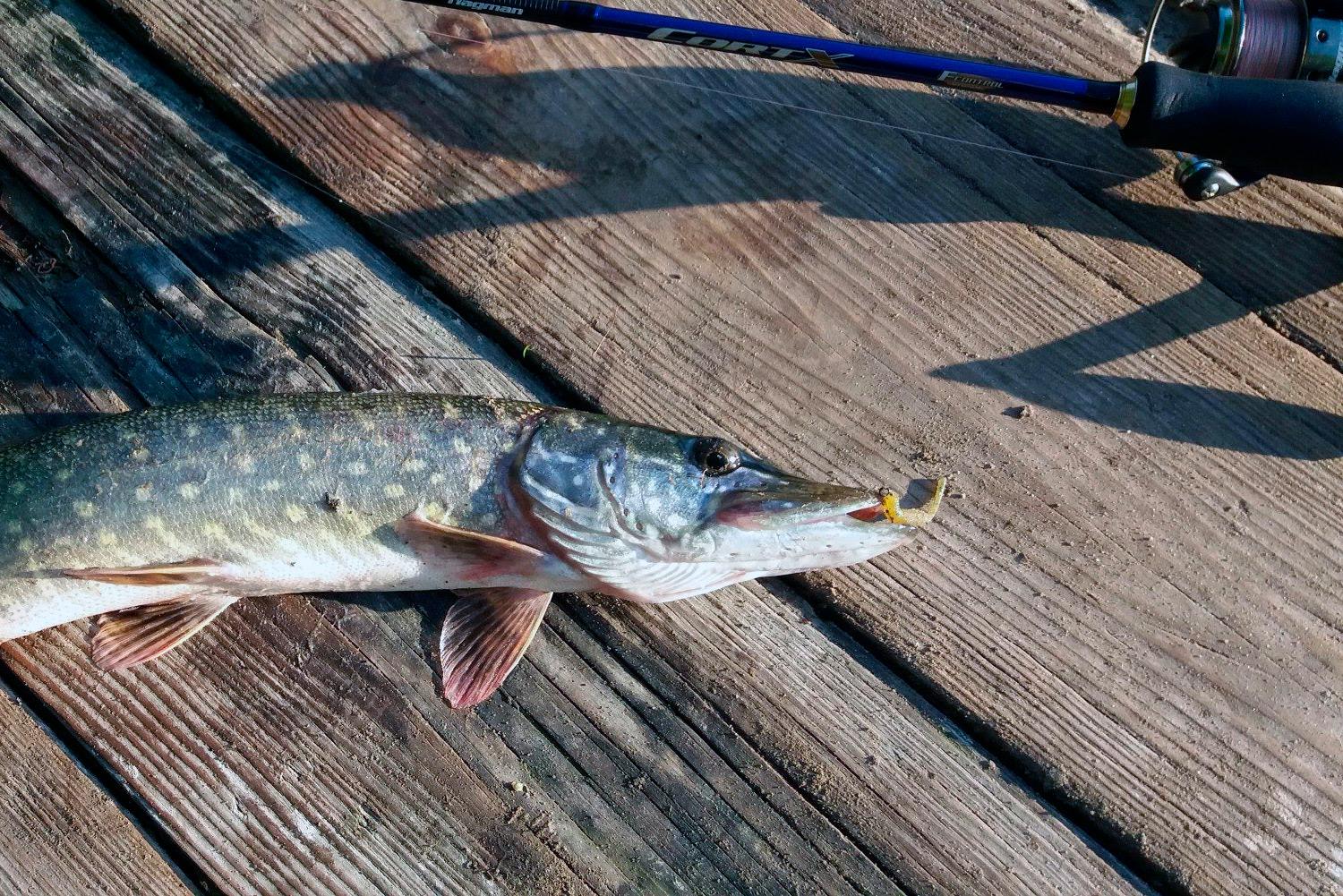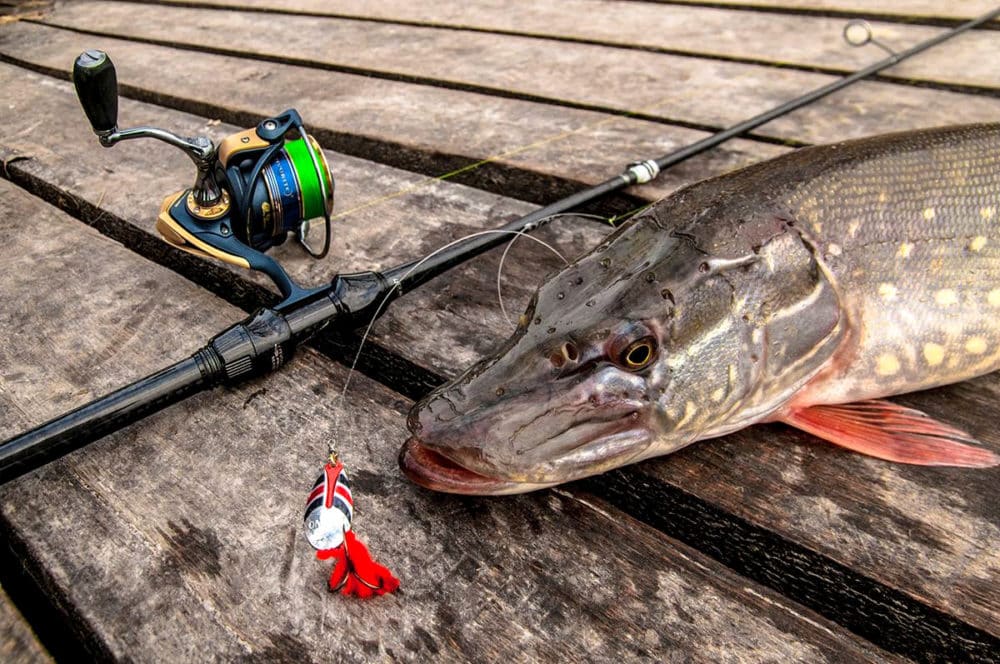The diverter leash (or Moscow rig, is also one of the options for paternoster – feeder mounting) is a classic spaced jig rig, often used in the middle latitudes of the Russian Federation and the CIS for catching
perch , zander and pike. Today’s material will be about the peculiarities of fishing and the optimal conditions for using Moscow equipment for fishing pike.
- What is a diverter leash: design and features
- Installation of a diverter leash on a pike: rigging methods and tips, video
- The easiest installation of the diverter on the node on the main line
- Blind rig on one swivel with a break – the basic classic
- Blind rig on one in-line swivel
- Triple swivel – simple and effective
- Sliding weight mounting – maximum sensitivity and animation freedom
- About the installation elements – what you should pay attention to
- About baits
- How to catch a pike on a diverting leash: wiring and technique, video advice from experienced
- When and in what conditions is the pike diverter especially good?
- The search for a toothed tooth and the technique of wiring a diverter leash when fishing for pike
- We collect tackle for pike on the basis of a diverter leash
- Поделиться ссылкой:
What is a diverter leash: design and features
Diverter – a classic spaced mount for catching predatory fish, most often used with jig lures (although not a dogma). It is characterized by the fact that the load and the bait go on different leashes and in different layers of the water area – the weight is dragged along the bottom of the reservoir, and the bait goes at a given depth, depending on the installation. Thus, in general terms, the scheme is as follows – at the end of the working cord a sinker is knitted most often of an oblong shape – an olive, a stick, a fungus. Above the weight, in one way or another, a leash with a bait is knitted to the main fishing line with a cord. The length of the leash for a pike depends on the fishing conditions and can vary from 20 cm to 1.5 meters or more. One of the options for the classic Moscow swivel rigging (not the simplest, but the most common, judging by the popularity among colleagues):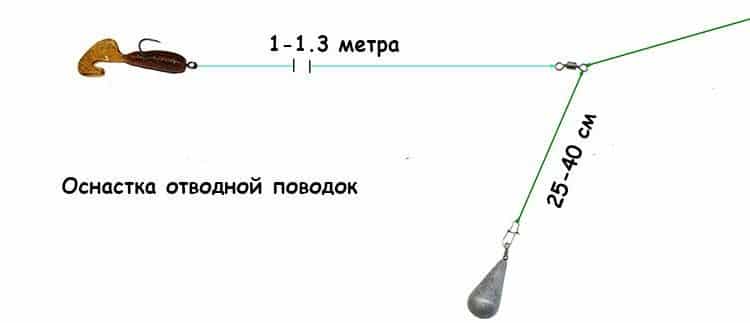
- Possible fishing with free-floating lures increases the attractiveness of the bait for predatory fish, and also increases the variability of the types of animation used.
- You can fish with relatively medium-sized lures, but at the same time using weighty sinkers, without reducing the number of bites due to the effect of the load on the natural behavior of the bait, there is also the possibility of fishing at great depths and an enviable casting distance – three in one!
- It is the retractable leash that allows you to catch accented with a tap in the hand at long distances. A regular jig, even on the most ringing blank, does not always reflect what is happening at the opposite end of the tackle. This is especially noticeable under a combination of conditions – great depth in a strong current.
- There are options for installing a diverter leash, which give a clear understanding of the depth at which the bait goes.
- The separation of the bait and the sinker gives the former maximum freedom, mobility and naturalness in animation. And this, in turn, improves the quality of animation and fishing in general.
https://youtu.be/Wf9hPBq-ITM
Installation of a diverter leash on a pike: rigging methods and tips, video
There are quite a lot of options for mounting a diverter leash on a pike, from the simplest to the intricate and intricate. Each has its own pros and cons, and it does not always just mean bad, and vice versa. It all depends on the specific conditions of fishing, the activity of the predator, the tackle to be used for fishing. For installation it is necessary:
- sinker;
- offset or regular hook with a large ear;
- bait;
- in some versions, additional fittings – swivels, fasteners;
- actually the spinning tackle itself.

- A bait lead is almost always longer than a lead lead.
- The bait lead is always thinner line / fluorocarbon than the main line on which the lead is attached.
- Most often, a run-down lead is used to make it easier to remove from the hook.
The easiest installation of the diverter on the node on the main line
This option is suitable if there is an urgent need to create an installation right in the combat conditions of fishing. Actually, the installation itself on the hinge is the first on the left (in turn from left to right: Moscow on the hinge, on the swivel, on the fastener with the swivel, sliding version):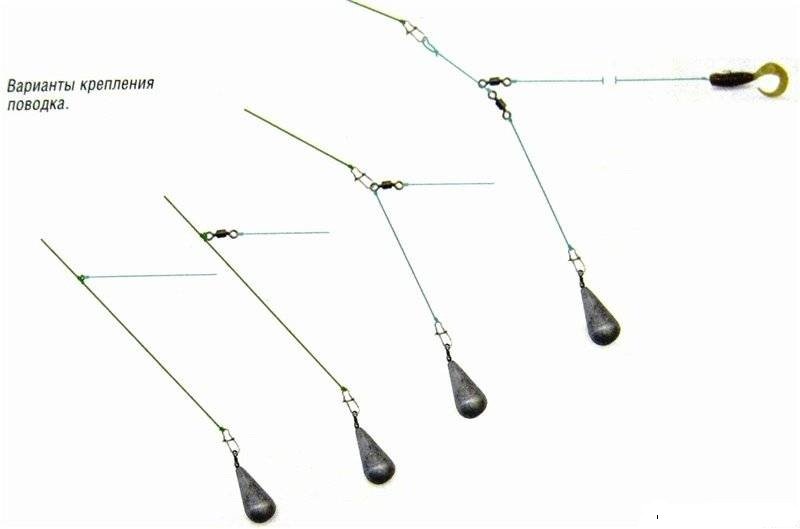


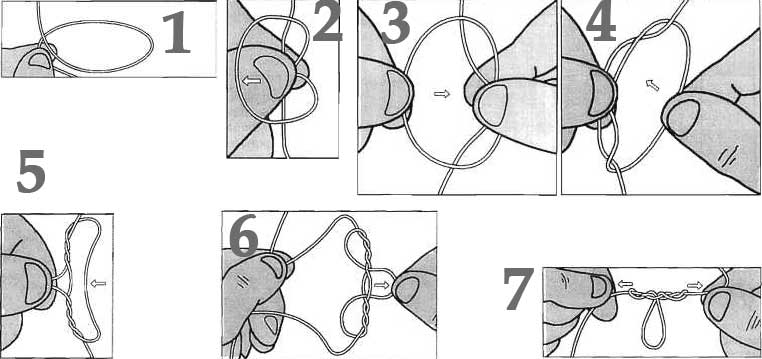
Such a knot can no longer be untied and it is worth using it if it is supposed to fish on the outlet for a long time.
https://youtu.be/mtH_KySHGOk Or, for example, such a temporary one, in which the loop on the main cord can be released if necessary, without transferring an expensive braid / fluor: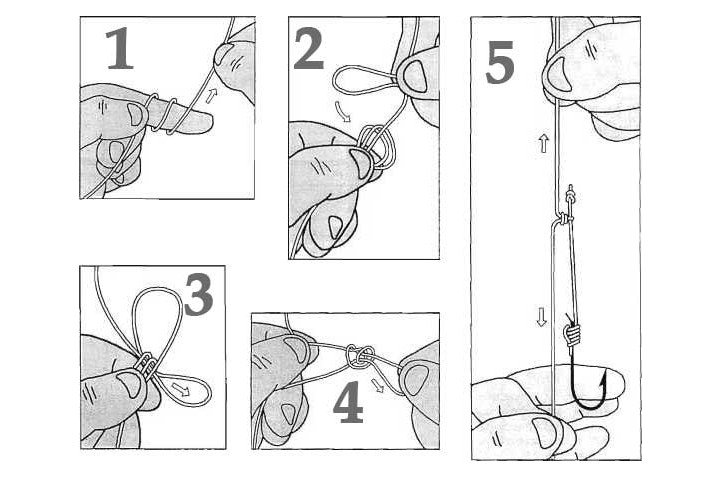
Remark # 1. On a leash with a hook, an 8-type stopper knot is tied, it is cut off, if necessary, dissolve the loop. Remark # 2. To open the loop, you need to pull the two ends of the main line in different directions, after pulling out the leash from the loop with the previously cut stopper knot.
To the resulting loop, a loop in a loop is knitted with a leash at the end of which, through a fastener or on a blind, the bait is knitted without a load.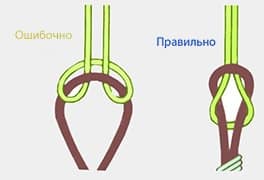
On the average, we can say that the classic dimensions of the Moscow rig are as follows:
- working leash size 80-120 cm;
- the size of the loaded leash is 20-40 cm.
That is, the ratio is 3 to 1 – approximately, of the working and loaded parts.
Of the advantages, the obvious – quickly, without additional accessories and with a minimum of knowledge – it is enough to know how two or three knots are knitted. Of the minuses – the risk of losing all the equipment when hooked, such an installation also spins very strongly, especially when used on a current, well, and low versatility – without adding additional components in the form of fasteners, you can quickly replace either the load or the bait. That is, we use such an installation for aggressive running fishing, when there is no time and opportunity to catch a promising pike point that suddenly happened, where Moscow equipment is urgently needed here and now.
Blind rig on one swivel with a break – the basic classic
Really classic installation of a diverter leader, which is often used for pike fishing, but not the best option. Both from the point of view of the convenience of fishing, and from the point of view of a purely fishing component, there is no that catchability and versatility that other equipment options can give. A swivel is tied to the main fishing line; a diverter leash is tied to the same eye of the swivel, the average length of which is 15-40 cm; a string / fluorocarbon leash, 60-120 cm long, is knitted in the other ear of the swivel.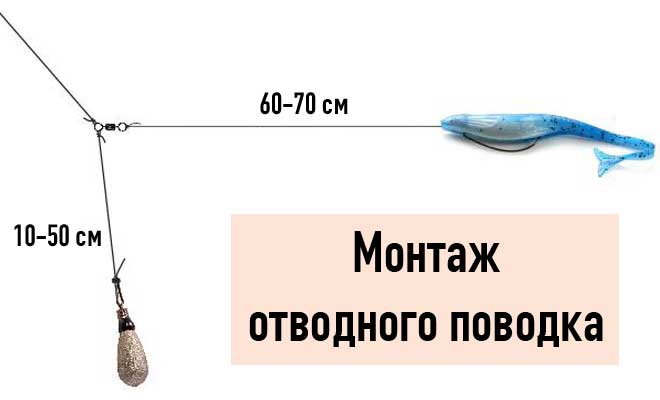
In order to minimize the number of overlaps, it is worth empirically choosing the length of the baited and laden leashes, and also using hard flux as the material for the leash with the bait.
As you can see from the photo, a gap is formed at the point where all parts of the rig meet. Is it good or bad? The advantage is that when hooked with a bait or a load, one thing is lost. The bad news is that a large number of knots reduces the basic strength of the installation, and knitting it is undoubtedly more difficult and longer than the previous and next option. Therefore, the option is as follows:
Blind rig on one in-line swivel
In this case, the swivel is tied directly to the main line, forming an attachment point for the leash. That is, there is no break in editing, as in the previous version. A swivel is knitted on the main line either through a double loop – a “bridle” knot (this option allows you to move the leash with the bait along the main line, which is undoubtedly a plus if the fishing is dynamic in terms of changing places), or blindly by one of the main known knots, for example, clinch. A leash with a bait is attached to the second ear of the swivel. The lengths of the leashes are also selected empirically. But in general, the rule is the same – the ratio is about 3 to 1, but in fact it is selected based on the fishing conditions.
Triple swivel – simple and effective
Installation of Moscow wiring on a triple swivel is the most intuitive and simple. Each ear is tied with a main fishing line, a leash with a load and a leash with a bait. Complete freedom in the behavior of all parts of the rig in this case, plus and minus, – it behaves as naturally as possible, but with improperly selected leash lengths and thicknesses of leash materials, overlaps are also frequent, as in previous versions, and sometimes even more annoying when using thin woods. This method is promising and appropriate to use in places with a large number of hooks, especially on the ridges of stones, in which the sinker often gets stuck.
The diameter of the lines with this installation is selected in this way the diameter of the main cord> the diameter of the loaded leash> the diameter of the bait leash.
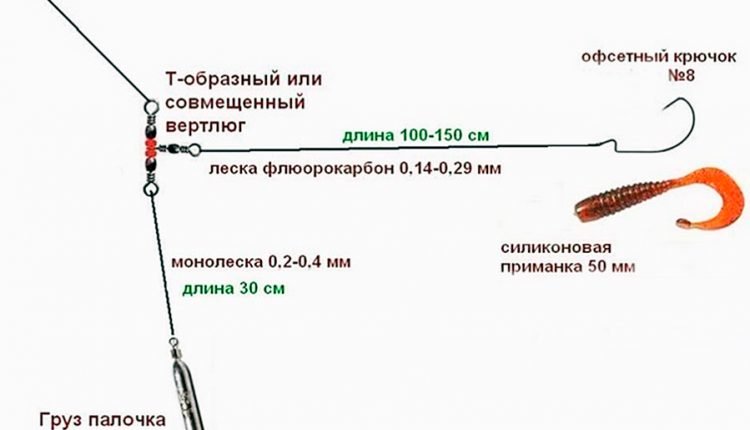
Sliding weight mounting – maximum sensitivity and animation freedom
Such equipment is clearly shown in the photo: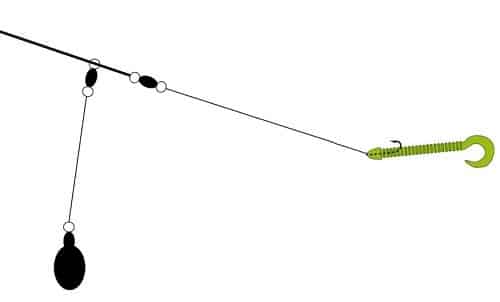
Elements of equipment – leashes can be tied at home and wound on the reel, then in working conditions you will not need to waste precious time.
About the installation elements – what you should pay attention to
As already noted, for the Moscow rig, it is worth picking up
weights of a projected shape – a pear, an olive, a Tyrolean stick, a bullet. Preferably with a built-in swivel to minimize twisting of the line and, as a result, the number of overlaps. The weight should be selected based on the speed of the current, the required casting distance and the required animation speed (read – the activity of the predator). On
hooks, it is preferable to use offsets, since the diverter often involves fishing in difficult overgrown and cluttered places. Offset hooks reduce the number of blank leads and breaks. The basis is a
braid , it transfers the bite well and clearly taps into the hand all the obstacles at the bottom. Leash with bait
from fluor , it is less confused and overwhelmed by a leash with a load. The diameter for a pike should be impressive (0.3-0.4), otherwise the toothed one will easily cut thin material.
About baits
The diverter is a classic of spaced jig equipment, and the main jig baits are also used – vibrotails, worms, slugs, crayfish, twisters, foam rubber. But this does not negate the fact that on the Moscow one you can successfully catch with wobblers, a fish that has been removed, in some cases you can also successfully catch with wide slowly falling spoons.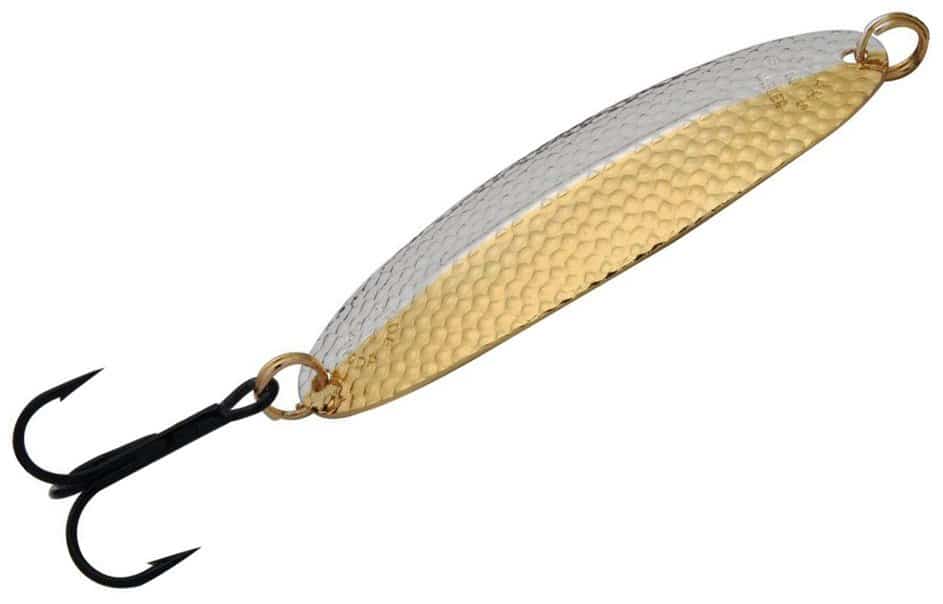
here .
How to catch a pike on a diverting leash: wiring and technique, video advice from experienced
When and in what conditions is the pike diverter especially good?
Based on the advantages of the diverter leash, outlined above, in conjunction with the habits of the pike, several characteristic points and conditions can be distinguished when the Moscow rig will come in handy when catching a toothy predator. The jig spacer should be used on deep river dumps, especially steep – near ones, if necessary, process the promising point with a slow – short step, the rack should hold the bait longer in the required place of the edge; distant, in order to throw the bait and qualitatively work out the necessary water area on the far edge, without the influence of a massive load on the jig. Such points are typical sites for river pike. It is good to use the diverter when fishing from a boat, practically in a plumb line, you can also fish in a plumb line from steep banks, practically playing with a bait in one place, catching the most promising points of the river as tightly as possible.Another option for using a diverter lead is fishing on river, overgrown shallows, where pike often goes hunting, especially at dawn. In this case, the diverter is knitted in such a way that the load drags along the bottom (albeit collecting grass and other growth), and the fish (worm, twister) goes at a certain clearly defined distance from the bottom, freely animating and attracting a predator.
The search for a toothed tooth and the technique of wiring a diverter leash when fishing for pike
Fishing for pike, especially river and autumn pike, often takes place in deep places, on a coiled and muddy bottom. In such places, the predator often stands almost motionless, moving along a small water area from ambush to ambush. It is in such a situation that the slow lazy wiring of the bait on a diverting leash is especially relevant, when the jig is going at some distance from the bottom, without falling into silt, bottom driftwood and stones, autumn fallen leaves, grass, etc. That is, we tap the bottom on a sensitive Moscow sliding rig, while the bait always moves at a given distance at the bottom, no matter how the relief changes, but at the same time, without touching it! How to catch pike on a drop lead in autumn: https://youtu.be/AYmvYF13hGI
This is an important bonus, which is very important when fishing for pike with a diverter line, especially in late summer and autumn. Hold the bait as close to the bottom as possible, but without collecting all the bottom debris.
In order to further reduce the number of hooks, it is worth using running weights and equipping jigs on offsets. In summer, when fishing on steep edges and in pools under the banks, as well as in points with strong currents and great depths, you can use heavily loaded branch pipes, which allows you to tap the bottom with a short step as slowly as possible, go along the ditch by dragging a weight, or, using short explosions, make undulating wiring at the very bottom. It is possible and necessary to diversify the wiring by playing along with the tip of the blank, varying the amplitude and frequency of oscillations. If the fish is extremely passive, pauses with barely noticeable movement of the bait at the bottom give a good result, this is especially true when using worms and slugs. Such dances on ice with constant falls to the bottom. The use of a variety of twitching postings is also permissible,consisting of short jerks and pauses.
We collect tackle for pike on the basis of a diverter leash
The blank for fishing with a lead-in must be as loud and sensitive as possible. This is due to the fact that the sensitivity in the hand with the Moscow rig is still lower than with the standard jig. The action of the rod is fast or extra fast. But the tip must be sensitive enough so that different types of animation can be played. Length 2.2-2.7 meters. Standard, convenient for casting over long distances and when fishing for pike at the feet at a distance of 20-30 meters. The spinning test depends on the weight of the sinkers used. For medium and small, it is usually enough for pike fishing 5-21; 10-30; 15-35 grams. Reel 2000-2500 Shimano, on the spool – braid 0.12-0.15 under the edge of the side. Smooth braiding, smooth running. This is what almost all middle class and higher spinning coils have. Diverter leader – catchy installation,but like any other tool it needs to be used wisely and in the conditions, any tool is good in the conditions for which it is intended.
